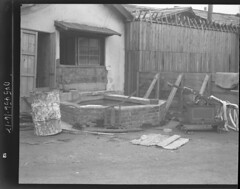
and Fire fighting apparatus, Yodogawa Prison Camp.

We have plenty more of these if there's any interest.
An unofficial blog about the National Museum of Health and Medicine (nee the Army Medical Museum) in Silver Spring, MD. Visit for news about the museum, new projects, musing on the history of medicine and neat pictures.


NLM "Turning The Pages" Adds Richly Illustrated Japanese Manuscript, Hanaoka Seishu's Influential Surgical Casebook
The National Library of Medicine, the world's largest medical library and an arm of the National Institutes of Health, announces the addition of Hanaoka Seishu's Surgical Casebook (http://archive.nlm.nih.gov/proj/ttp/flash/hanaoka/hanaoka.html) to its growing collection of virtual books and manuscripts available for thumbing through online via Turning the Pages (http://archive.nlm.nih.gov/proj/ttp/intro.htm). The virtual volume is also available on kiosks in the Library's Visitor Center (Building 38A, first floor) and the History of Medicine Division Reading Room (Building 38, first floor), and marks the continued collaboration of the Library's Lister Hill Center and the History of Medicine Division.
The newest addition to Turning the Pages is a magnificently illustrated manuscript depicting the likenesses of the men and women who came to Hanaoka for treatment in early 19th-century Japan. It is the first in the collection in which users will turn the pages according to Japanese custom, right to left.
Hanaoka Seishu (1760-1835) was a pioneering Japanese surgeon who was the first to use general anesthesia to remove tumors from cancer patients. The images in the Surgical Casebook are colorful, often charming, and depict quite graphically the medical and surgical problem to be treated.
Hanaoka studied both traditional Chinese-style medicine and Western-style surgical techniques. At age 25, he took over the family business and began to practice an eclectic style of medicine that combined these two traditions. He was greatly concerned with his inability to treat cancer patients, and over a period of 20 years he developed an herbal concoction he called "mafutsusan," made up of several highly toxic plants. It did not include opium derivatives which European doctors were only beginning to identify as anesthetics. The narcotic effects of Hanaoka's anesthetic could last as long as 24 hours, allowing him to surgically remove many different kinds of tumors which previously had been inoperable.
Images from the manuscript were selected and curatorial text was written by Dr. Ann Jannetta, Professor Emerita of History at the University of Pittsburgh. The descriptive text can be viewed if one clicks the "T" in the upper left corner of the virtual book page.




